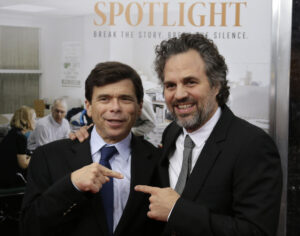In 1986, Patrick McSorley was a 12-year-old-boy living in a Boston housing project. His dad had just committed suicide, and his mom was schizophrenic. One day, a Catholic priest named John Geoghan showed up at Patrick’s home and offered to buy him ice cream.
Riding home after getting ice cream, McSorley says, Geoghan consoled him. But then he patted his upper leg and slid his hand up toward his crotch. … When Geoghan dropped a shaken McSorley off at his mother's house, he suggested they keep secret what had taken place. “He said, ‘We're very good at keeping secrets.’”
McSorley’s tale was woven into the first story The Boston Globe published in 2002 exposing the Catholic sex abuse crisis, a monumental investigation that won the paper the 2003 Pulitzer in Public Service. The basis for the Oscar-winning movie “Spotlight,” it revealed how church leaders had moved serial abuser Geoghan from parish to parish.
After reading that story, you might not remember how many lawsuits were pending against Geoghan (84) or how many people had accused him of abuse (more than 130). But you’ll remember the boy who went to get ice cream and was violated instead.
A great investigation delivers on two levels: It has scope, and it has specificity. It shows not only how a system failed, but why readers should care that it did. Jaw-dropping as the Globe’s revelations were, the stories needed faces. They needed voices.
Although none of the paper’s Pulitzer-winning articles is purely a narrative, in even the most hard-hitting reports, the writers nearly always tucked in powerful details and quotes — the building blocks of storytelling. In doing so, they humanized even some of the scandal’s less sympathetic figures.
Despite myself, I felt a pang of sympathy. That’s what even a few paragraphs of storytelling can do: transform someone from a caricature into a human being, link “us” to “them.”

Such details are hard-won. In 2013, when I was a reporter at the Los Angeles Times, I worked with two colleagues on a series exploring how the abuse scandal unfolded in the L.A. archdiocese. We trawled through thousands of pages of newly released church records: Victims’ letters. Diocesan memos. Psychiatric reports so graphic that I still can’t stomach movies where molestation is a plot point. I interviewed victims and their families who, decades after the abuse, wrestled with rage and shame. One man asked me to meet him in a city park, the only place he could think of where no one would overhear us.
And we had the advantage of the Globe paving the way. Though the National Catholic Reporter, the Boston Phoenix and other outlets had dug into abuse scandals before, at the time of the Globe investigation, victims were still routinely tarred as liars or money-grubbers, if they were acknowledged at all. The Globe vindicated their allegations of a church cover-up, and then some — it was the domino that toppled the rest of the line.
The nearly two dozen stories in the Globe’s Pulitzer entry (out of an astonishing 600 published that year on the scandal) were tightly crafted. Each focused on a single aspect, and together they created a pointillist picture of the crisis.
One piece by Kevin Cullen discussed how Massachusetts power players were starting to stand up to the church — a story whose underlying question was, What took them so long? Instead of simply stacking quotes from prosecutors and lawmakers, Cullen took a more novelistic approach: He introduced interviewees by delving into their Catholic roots, thereby showing why they’d deferred to the church for so long, and how astounding it was that they no longer did.
Attorney General Thomas F. Reilly grew up in what he calls “a typical Irish Catholic family.” His immigrant parents were deeply religious. … ''We knelt down and said the rosary, as a family, every night,'' the attorney general remembered. Reilly fondly recalls the Sisters of St. Joseph who taught him at Cathedral High School. His mother and a priest worked as a team to get him into a Catholic college in Canada. ''The church I grew up in cared about kids,'' said Reilly.
In another story, Ellen Barry took readers into the world of church-funded psychiatric centers. The church didn’t allow her to tour them, and the piece could have easily sputtered. But Barry braided in historical context — one center’s founder suggested the church buy a Caribbean island to house pedophiles — and unforgettable anecdotes. For example, a priest named Jay Mullin had been accused of abuse and shipped to a facility in Maryland that treated clergy from around the country. St. Luke Institute forced them to undergo a test that measured arousal levels: the plethysmograph, or “peter meter.”
He still shudders when he remembers the plethysmograph, and the pleas he made to the Archdiocese of Boston to exempt him from the test. On the ride back to St. Luke Institute, he said, his driver pulled over and got out of the car so he could cry alone, Mullin said. “They're observing me. They're videotaping it,” he told a Globe reporter. “They finish up with kiddie porn, my first introduction to the whole pornographic industry. It was not a joy by any shape.”
Despite myself, I felt a pang of sympathy. That’s what even a few paragraphs of storytelling can do: transform someone from a caricature into a human being, link “us” to “them.”
After reading that story, you might not remember how many lawsuits were pending against Geoghan (84) or how many people had accused him of abuse (more than 130). But you’ll remember the boy who went to get ice cream and was violated instead.
Considering my immersion in priest abuse documents, I was convinced nothing in the Globe series could devastate me. I was wrong. In a quick-turn feature, Walter V. Robinson (played by Michael Keaton in “Spotlight”) introduces us to a father and son who were both abused – and the woman who is wife and mother to them.
Father and son have much in common: Both have nightmares. Both still try to shake the sense of guilt and shame. Tom never told his parents; Chris said nothing until the day five years ago when Geoghan was publicly identified as a sex abuser.
"We were watching the TV news. I was sitting next to Mom," Chris recalled as his mother struggled to fight back tears. "And there was Geoghan, being accused of abusing all these children. And my Mom said, 'That bastard.' And I said, 'Mom, I'm one of them, one of the victims.' She just looked at me. She didn't know what to say. So we just walked upstairs, and we told my dad."
As an adult, Chris refused to even step into a church; every one reminded him of his molestation. He still had dreams about Geoghan. Nightmares, really. And whenever that happened, no matter the time, he rolled out of bed and showered.
These details weren’t extraneous. They didn’t sap the investigation’s power; they enhanced it. The Spotlight team clearly understood this: They gave a casual reader, one with no direct stake in the story, something to latch onto. You may not be a practicing Catholic. But you understand pain. You understand the sting of betrayal, and how hard that is to wash away.



